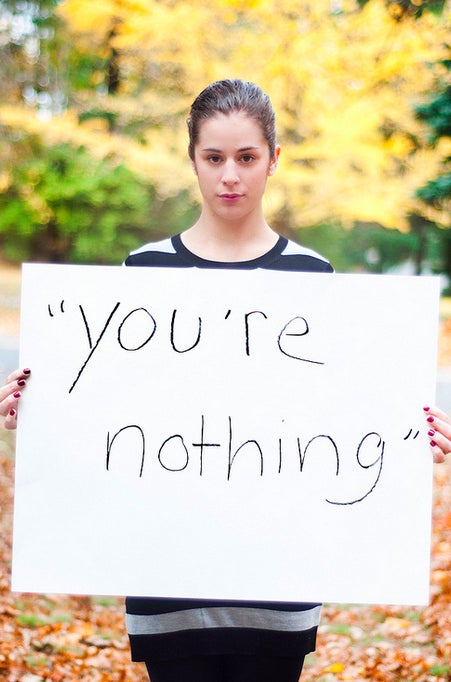
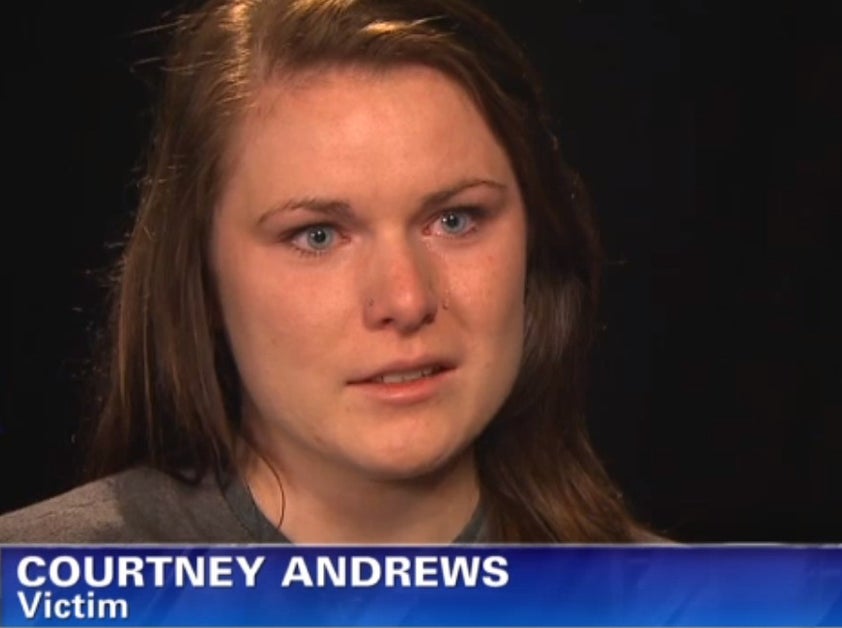
Left: Project Unbreakable's Kaelyn Siversky, quoting her attacker. Right: Andrews on CNN.
Courtney Andrews made the decision somewhere around Birmingham.
It was Nov. 13, and she was driving from Athens, Ala., to Mobile, Ala. — a 350-mile stretch from one end of the Heart of Dixie to the other — when her phone rang.
There were four, five, six reporters who wanted her contact information, Andrews' aunt told her. Did she want to talk to them?
Andrews, a 20-year-old exercise science student at Mobile's University of South Alabama, paused. "I'm kind of a shy person. I was like, am I really about to do this? Is this really about to happen?"
She turned around, heading back toward Athens and the courthouse where reporters were waiting for her. Where earlier that day, 25-year-old Austin Clem — convicted of raping her at ages 18, 14, and 13 — had been sentenced to a mere two years of a "community corrections program," dodging any jail time.
Reporters already knew Andrews' name, but following a decades-old media tradition, they had identified her for months as Clem's "former neighbor" or "teenage acquaintance." Now, on her drive back to Athens, Andrews' mother called. "You know this is putting your name out there," she told her daughter.
"I know, mom," Andrews said. "Everybody's going to know what happened to me. Everyone I grew up with. All the teachers I had."
The red-faced, teary-eyed mugshot of Clem, a father of three girls, had been the face of the story. Now Andrews, a sporty brunette with piercing blue-gray eyes, was its central figure, the "victim."
"It was something I needed to do," Andrews told BuzzFeed two weeks after Clem's sentencing. "It wasn't a choice anymore. It's about protecting people from him."
Every year, more women make the decision Andrews did, choosing openness over shame, telling their families, their neighbors, and anyone who searches for them on Google that they've been the victims of sexual assault. Their motivations and methods vary, but the road has been cleared for them by a generation more accepting of talking about sex and sexual crimes. The internet, with its incongruous combination of intimacy and range, has given young women contemporaries to look to as examples, and a platform where their peers are listening. Their decisions are increasingly part of a global, online movement — one that reflects a dramatic reversal from the near-universal consensus of a mere decade ago.
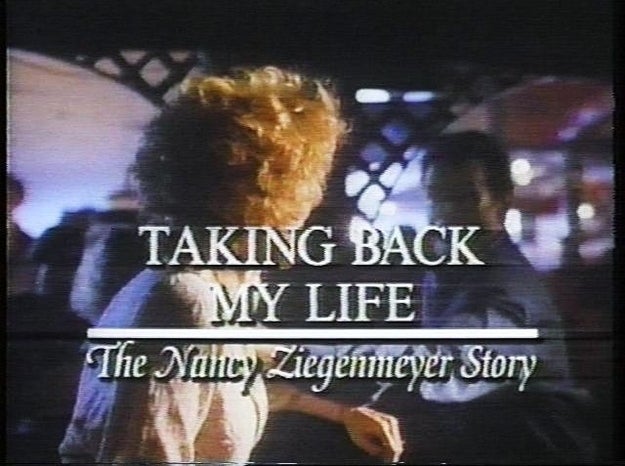

Left: The title frame from Ziegenmeyer's movie. Right: Geneva Overholser, the newspaper editor who brought her story to light.
The contemporary feminist revolt against the well-intentioned media rape shield began in earnest in Des Moines, Iowa, in 1988. That November, a man wearing a navy pinstripe suit and smelling of alcohol raped 29-year-old Nancy Ziegenmeyer in a parking lot in the middle of the day. Local media covered Bobby Lee Smith's trial and conviction, while following its long-held (and still-held) policy of withholding names of victims of sexual violence. The following year, Des Moines Register's then-editor Geneva Overholser wrote a column criticizing this policy and urging rape survivors to come forward.
"I believe that we will not break down the stigma until more and more women take public stands," she wrote.
"Rape is an American shame. Our society needs to see that and attend to it, not hide it or hush it up. As long as rape is deemed unspeakable — and is therefore not fully and honestly spoken of — the public outrage will be muted as well."
When she read Overholser's column, Ziegenmeyer reached out to the newspaper. "She said she hated being told to shut up," Overholser told BuzzFeed. The Register won a Pulitzer for the series [.pdf] that followed, identifying Ziegenmeyer and telling her story.
"It just had never been done before," said Overholser, recalling a moment during production when she hunched over a copy editor's shoulder as the editor changed "after he had ejaculated" to "when he had finished."
"I said, 'No, no, no, that sounds like he had lunch.'" She changed it back.
Ziegenmeyer's story made the front page of The New York Times. Her photo was in Esquire and People. There was a movie, and dozens of women wrote into the Register, wanting their stories to be told. The series' success inspired newspapers around the country to run stories about rape survivors willing to be named. And it still does. In October, the Kansas City Star's investigation into the 2011 rape of 16-year-old Daisy Coleman — in which Coleman identified herself to pursue justice against her attacker — and the subsequent Anonymous campaign was picked up by every major national news outlet.
"I think there's a lot of pent-up desire to come forward. It's a fairly natural thing, when a terrible thing happens to you, to want to talk about it," said Overholser, former director of University of Southern California's journalism school.
Overholser's criticism of the media shield has only intensified since 1989, as the ethical questions surrounding the policy pretty much stay the same. Overholser doesn't believe reporters should go out of their way to identify victims, but she calls the protection of rape victims — as opposed to, say, robbery victims — "social work" and "a continuation of the stigmatization."
"Does this protection really serve well the needs of women?" she said. "We have never, never had the appropriate standing to decide who needs 'protecting.' No innocence or guilt has been determined in court when newspapers make the decision to withhold names. And it's an illusion to think that you'll be just fine if we don't put your name in the newspaper."
And what was once seen as a lonely crusade — one deeply discomfiting not only to journalists, police, and judges, but also to fellow feminists — has gradually gained broad traction among rape survivors and the people who work with them.
"We've definitely seen a lot more people willing to use their name in press stories or willing to discuss publicly what happened to them," said Scott Berkowitz, president and founder of the advocacy organization Rape, Abuse, and Incest National Network (RAINN). "We're still a long way from everyone wanting to be public, but there's definitely a trend."
Berkowitz's caveat is important: According to the Justice Department, only 40% of rapes and sexual assaults are reported to authorities. Even fewer reach the media. But the increase in survivors coming forward is "progress," Berkowitz said. He believes it's a sign of society's general opening up in matters of race, gender, and sex. News outlets report more on rape than they used to; TV shows have more sexual assault story lines than they used to.
"There's a much better societal understanding of this crime," he said. "We used to hear very frequently that people didn't think they were going to be believed if they came forward. That's a less frequent thing now."
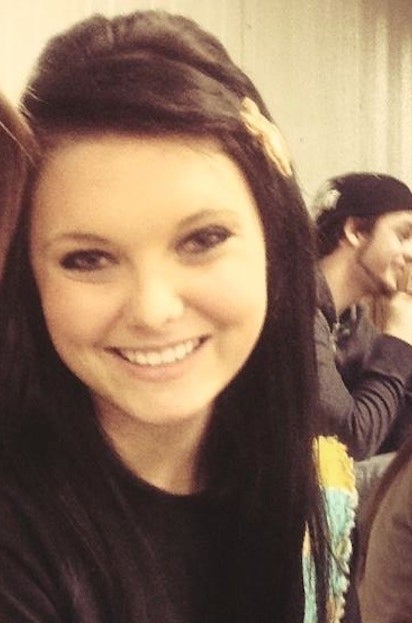
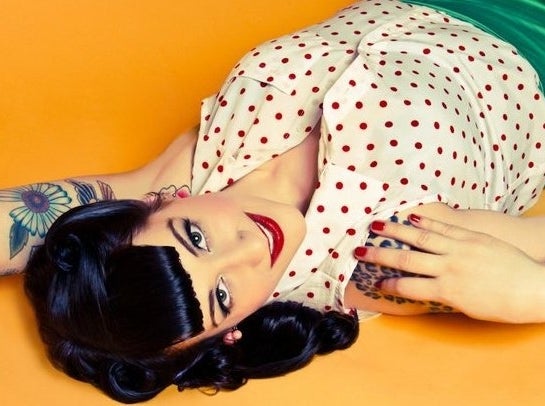
Left: Daisy Coleman. Right: xoJane Executive Editor Emily McCombs.
The change that Overholser helped ignite has accelerated with the growth of a new web culture and a generation that grew up with its bluntness. The internet has become a "personal printing press," as Overholser said, an always-open open-mic night where you can share your life with strangers while staying, to some extent, detached by virtue of distance. As long as message boards and blogs have existed, they've been platforms for people looking to "come out" as whatever they are — gay, political, an addict, a survivor — and connect.
"There's safety in numbers," Berkowitz said. "The more people see others doing it, the more willing they'll be to do it."
Not long after Daisy Coleman's name began bouncing off the echo chamber of cable news, she published a first-person essay on xoJane, a website well known for its startling "It Happened to Me" confessions.
"My whole life since January 8, 2012, has been a long, reckless winter," Coleman wrote. The piece was tweeted nearly 7,000 times and commented on more than 1,000 times. Coleman was paid for her contribution, and she continued over the next few weeks to tweet about her case with the popular tag #Justice4Daisy.
Some critics believe reporters should have questioned the "counseling and guidance" given to Coleman — and other minors who choose to come forward in this fashion — before "throwing out their policies" and naming her.
"Just because a rape victim chooses to identify herself does not mean news organizations should necessarily follow suit," journalist Allison Yarrow wrote on Al Jazeera Amercia's website just last week. "In other words, the disclaimer that she did it first is not enough."
In 1989, rape counselors overwhelmingly agreed; they were the most vocal critics of the Des Moines Register's Ziegenmeyer series, arguing that a lack of privacy could hurt the healing process. But today, Berkowitz said he sees more good than harm in survivors coming forward.
"It can be cathartic to write about it online and lay it all out there," he said. "And it helps the public see that this is not a rare occurrence, that sexual assault happens every two minutes in the U.S."
RAINN has seen the effects of this catharsis through its own services, Berkowitz said. On Saturday, Nov. 16, for the first time ever, the National Sexual Assault Online Hotline — launched in 2006 — received more inquiries (136 visitors) than its long-standing phone hotline (127 visitors).
While Berkowitz praises the internet for providing this kind of access, he acknowledges it can hurt rape survivors, too, by providing a platform for the dissemination of their identities when they don't want to be identified. During last year's rape trial in Steubenville, Ohio, news outlets withheld a 16-year-old girl's name after she pressed charges against two football players who raped and filmed her in various states of unconsciousness. People who didn't like this girl or believe her story planted her name across Twitter, Facebook, and Reddit.
Survivors — whether they identify themselves or not — also learn very quickly to avoid comments sections of stories posted online about them. In that dimly lit anonymous space, they're accused of lying, deserving it, or asking for it.
"The internet is a really unforgiving place to talk about your rape," said xoJane's executive editor, Emily McCombs, who attributes the upswing in survivors gone public to a political climate in which women are generally "fed up about a lot of things."
"There's an undercurrent of misogyny and hate, and I don't blame anyone for never wanting to come out about their rape. It's so painful and there's such a stigma," she said. "I don't always want to write about being raped. But at the same time, I know everytime I do or someone else does, it can help another person understand what happened to them. Putting your name to it is an act of bravery."
On the day of xoJane's launch, McCombs, 30, published an essay about confronting a man who raped her in 1997 and then friended her on Facebook a decade later. It was a story she shopped around to women's magazines before she started to work with Jane Pratt, the founder of xoJane (and Jane and Sassy magazines). "Nobody would touch it," McCombs said. Her memory of the rape was "hazy, spotty," with some pieces surfacing after she got sober — not the kind of clear-cut event you see dramatized on TV.
"People think rape is when someone jumps out of the bushes with a knife and grabs you and forces you to do something while you kick and scream. That's not what rape looks like," McCombs said. "Continuing to talk about my rape is my way of fighting against that paradigm. It took me a decade to even realize I had been raped."
Last year, she said a similar thing to xoJane readers in another essay: "I don't want to be 'rape girl,' necessarily, but I am willing to be."
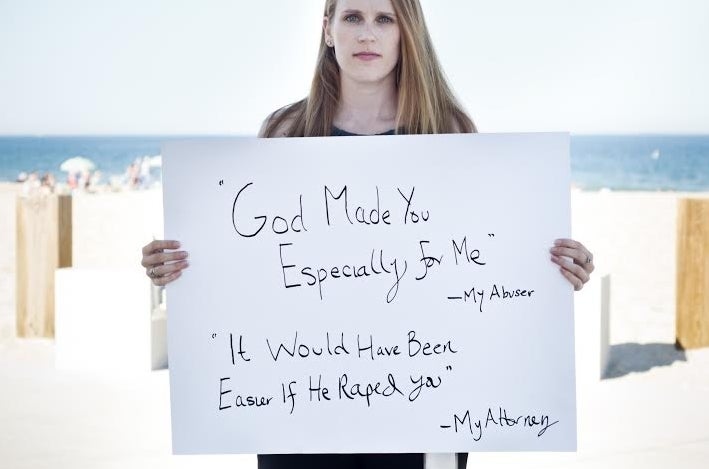

Project Unbreakable photos by Grace Brown.
Perhaps the rawest, and most widely viewed, discussions of rape online began in late 2011, when photography student Grace Brown published several portraits of people she knew who had been sexually assaulted. They held up posters with handwritten quotes from their attackers. Many victims' faces are visible.
Brown posted the images to Tumblr and asked for submissions; it wasn't long before the queue was pages long, filled with photos of men and women of all ages. All "Project Unbreakable" subjects are anonymous; Brown's one hard rule is that she'll take names out of any given photo — not for privacy reasons, she says, but to keep the project consistent.
"The project isn't so much about survivor stories, but that surviving a sexual assault can happen to anyone," said Unbreakable Executive Director Kaelyn Siversky. "It's about awareness and about how many people it can happen to. The specific detail of the names isn't really important in what we're trying to do."
Brown, 21, believes survivors' willingness to put their story on the internet is a "sea change."
"I think we're all kind of sick of being kept silent," she said. "People are sort of recognizing they're a little bit less isolated, and that gives them the bravery to do it."
Brown isn't herself a sexual assault survivor, but Siversky is. In April 2012, she emailed Brown, wanting to be photographed. She didn't end up going in front of the camera until October.
"I really believed that if I started to talk about it, people would blame me for it," Siversky, 22, said. "There's a shame that's so ingrained within us."
There are more opportunities than one might expect for women on college campuses to come forward with their assaults. Siversky admired her peers marching in "big events," like Slutwalk and Take Back the Night, but held herself back. She wanted "something a little quieter," though she acknowledges the irony of finding an intimate place to tell her story on the internet. She realized the gravity of Unbreakable afterward, when Facebook friends from high school sent her messages and people in her hometown mentioned her photo to her family.
That response isn't much different from that of a survivor who "comes out" in more traditional media — something Siversky said she never considered doing.
"I thought, The media only wants the bad cases. The scary cases. The Penn State cases," she said. "Those obviously deserve attention, but the assaults that happen much more often are with boyfriends and spouses. A lot of people in those cases don't see themselves as survivors."
Siversky and other Unbreakable participants speak about their attacks as a form of therapy — a door they need to walk through in order to move on. But others come forward as a means of changing the legal system, like Daisy Coleman, whose Star investigation ultimately got her case reopened and assigned to a new prosecutor.
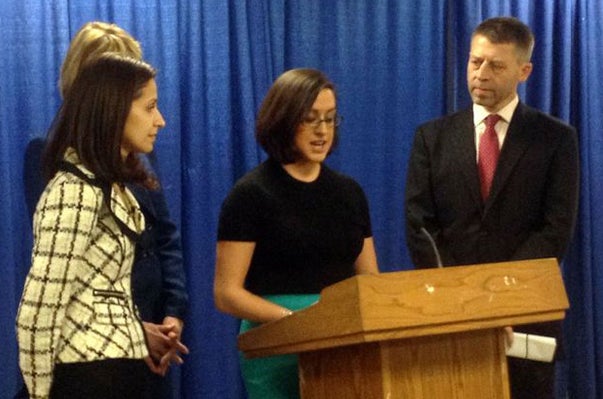

Left: Cuomo at a press conference in Albany on Feb. 12. Right: Clarke and her mother, Renee Touchton, at a press conference in Edgewater, Chicago, on June 2.
Lydia Cuomo, a 27-year-old Bronx schoolteacher, was raped by New York Police Department officer Michael Pena in 2011. He was convicted and sentenced to 75 years to life in prison. Cuomo later called it a "silver platter" of a rape case. But now she's working with lawmakers in Albany to expand the definition of rape in New York. Pena pleaded guilty to attacking Cuomo, and the jury convicted him for making nonconsensual oral and anal contact — both criminal sex acts that carry the same sentences as rape. But the jury was hung on whether he vaginally penetrated Cuomo, the state's definition of rape.
After passing a bill to change rape's definition in the New York Assembly last year, Cuomo will continue her fight in the state Senate in January.
For Cuomo, putting her name out there — after the trial, first to Slate and then to the New York Daily News — felt like the only way to garner support for her fight in Albany. But it was also her way of becoming more than "the victim" or "the schoolteacher."
"I really absolutely hated being referred to in the media without anyone ever actually talking to me. There was this awful feeling of watching someone dramatize your own story," she said. "It shouldn't be like that. This is not embarrassing, I never did anything wrong ... I've spoken to a lot of women who don't feel comfortable coming forward, and I think that's detrimentally sad. The more we talk about it, the more we change the conversation."
Alexandria Clarke, a 23-year-old recent graduate of Loyola University in Chicago, didn't think she would ever talk publicly about her rape.
In May, she was waiting at a city bus shelter when a stranger sat down next to her, grabbed her throat, and told her to walk with him. He threatened to kill her and told her not to make any noise. It was 2 p.m. — cars drove past them, and Clarke's phone was in her hand the entire time. When he finally turned down an alleyway, she tried to call 911. He took her phone and raped her.
When she reported the rape to police, Clarke said, she was surprised they didn't try harder to find her attacker during the first critical 48 hours.
"The detective I had was good, but she didn't do anything right away," Clarke said. "It was a Thursday, and then she had the weekend off or something. I didn't do a sketch or anything until three or four days later."
Clarke's mother, frustrated with the police's response, went to the press. Clarke said she "wanted to forget about and move on." But a few weeks later, when Clarke's mother announced a reward for any information leading to the attacker's arrest, Clarke stepped forward.
"I didn't even realize it was a big deal for women to talk about it in the media," she said.
RAINN's Berkowitz said reporting rape to police early — like Cuomo and Clarke did — is a critical step that's often delayed in the immediate aftermath of a traumatic sexual attack.
"The only way we're ever going to eliminate rape is by getting more rapists off the street, and for that we need more survivors to come forward," he said.
None of this is easy or simple. Survivors raped by friends or family members often don't report their attacks to authorities. The media covers the assaults of white women far more often than the assaults of women of color — and that's just in the United States. Women are assaulted all over the world, many in communities where speaking out could get them killed. And for survivors, coming forward is not a cure-all. Lydia Cuomo can't read many articles on assault without stumbling on a trigger that takes her "back to the moment it happened." Parents of her kindergarten students ask questions. Her "exhausting" Google results make dating awkward.
Berkowitz warns that this path isn't for everyone; RAINN, while providing a trove of resources for survivors reporting and recovering from assaults, would never advise all survivors to publicly identify themselves.
"If a woman came to us and said she was thinking about speaking out, we would try and draw her out on why she's inclined to do that and what she's trying to accomplish," Berkowitz said. In this way, survivors are still alone, guided only by the example of others they've seen come forward.
"Survivors need to make a decision about what's best for themselves," he said.
In several cases, a victim coming forward has changed the course of a legal case. When a judge gave Austin Clem a paltry sentence for raping Courtney Andrews, she fought back by identifying herself and drawing more publicity to the ruling. Last Tuesday, after Andrews' appearances on CNN and MSNBC, that judge filed an order agreeing to re-sentence Clem.
On a large scale, beyond these victories, women like Andrews are redefining "rape culture." They're gradually stripping away the taboo around talking about it, and the sense that the victims of sex crimes bear a special shame.
Andrews doesn't know about all that. She hasn't been sleeping well, and when we talk on the phone, she's emotional and congested, her Southern drawl raspy with a head cold.
"Yeah, so now people know that I'm the girl who was sexually abused. It's like I have no secrets," she said. "I'm not ashamed."
